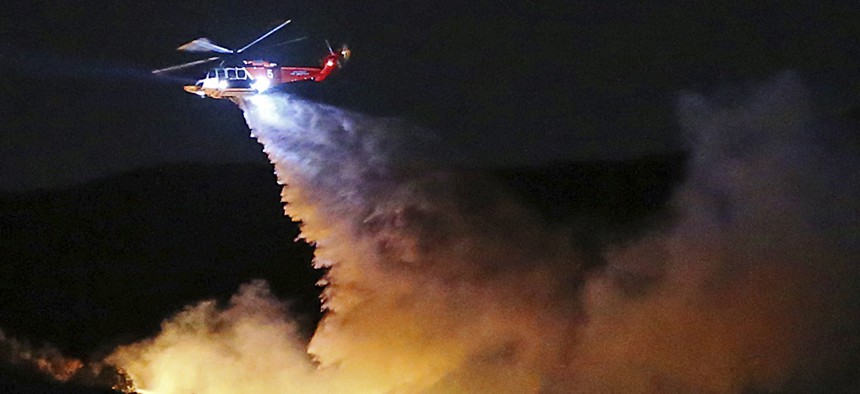Someone Flew a Drone Too Close to a Wildfire, Again

a helicopter drops water on a brush fire that broke out in Topanga State Park, Los Angeles. Reed Saxon/AP File Photo
Firefighters in Colorado had to ground their aircraft for an hour.
It happened again this week.
On Thursday, firefighting crews battling the Bocco Fire, which has burned hundreds of acres in Colorado, had to stop their efforts when an unauthorized civilian drone flew into their airspace. Neither tankers nor helicopters could fly for an hour while firefighters waited for the drone to clear.
“If you have aviation equipment moving quickly and they hit a drone, that’s going to cause significant damage and really be a safety issue for that pilot,” Steve Hall, a spokesman for the Colorado Bureau of Land Management, told Denver 7 ABC. “[It’s] not a distraction anybody needs—whether they’re on the ground or in the air.” (The bureau did not respond to a request for comment.)
It’s not the first time that civilian drones have frustrated forest-fire fighters. In 2016 alone, unauthorized drone flights led firefighting crews to ground their aircraft at least 13 times, according to the U.S. Forest Service. The service initiated a public-outreach campaign to try to dissuade pilots. Their tagline: “If you fly, we can’t!”
“Firefighting aircraft typical[ly] fly in smoky, windy, and turbulent conditions. Safety depends on knowing what other aircraft are operating in the airspace and where they are at all times. Consequently, their safety is compromised by the presence of a drone,” wrote Kaari Carpenter, who works in fire and aviation management for the service, at the time. She noted that drone pilots can face criminal charges and civil fines of up to $25,000 for flying near a fire.
Fires are not the only natural hazard that attract drone pilots. Last month, the Federal Aviation Administration ordered pilots not to fly uncrewed vehicles too close to the erupting Kilauea volcano on Hawaii’s Big Island.
Historically, the government has struggled to regulate unauthorized drone flights. Since drones can be remotely operated by their pilots, police officers cannot always locate the person actually controlling a drone, even if they can see the drone itself. But lately, their track record has improved.
Last summer, the state of Arizona charged a 54-year-old man with 14 counts of felony endangerment after he flew his drone too close to a wildfire, forcing other aircraft out of the sky. Several months later, a 24-year-old drone pilot was arrested after he flew a drone near the wine-country fires in Petaluma, California.
Drones do not only hamper firefighter efforts: Sometimes, they necessitate them. In March, an Arizona man lost control of his small, battery-operated drone in Coconino National Forest. The errant drone started a wildfire, burning more than 300 acres over the following day. The man was charged with starting a wildfire, which can carry a fine and sometimes result in jail time.




